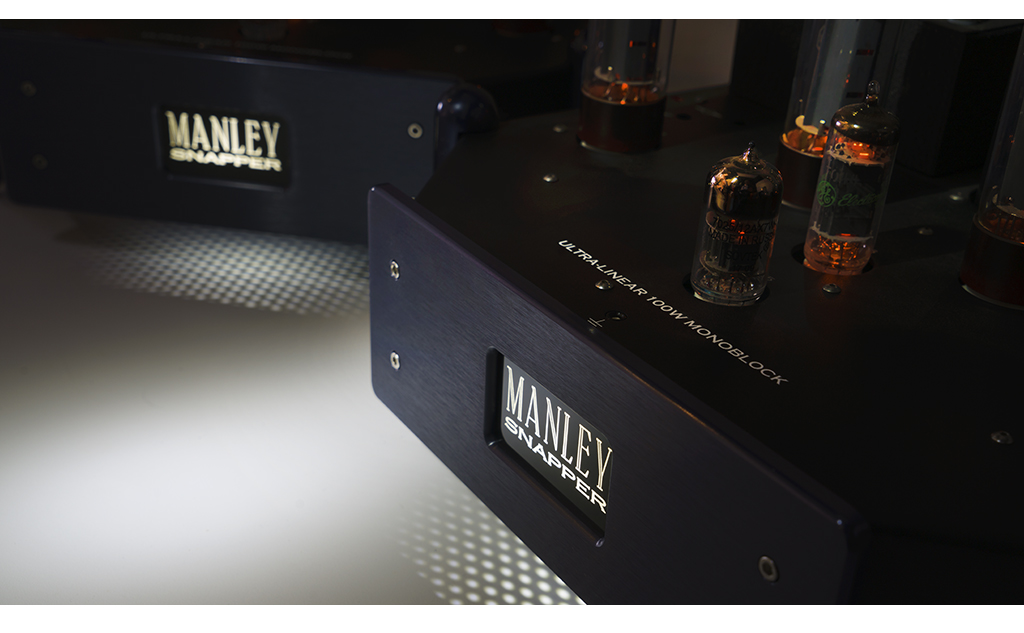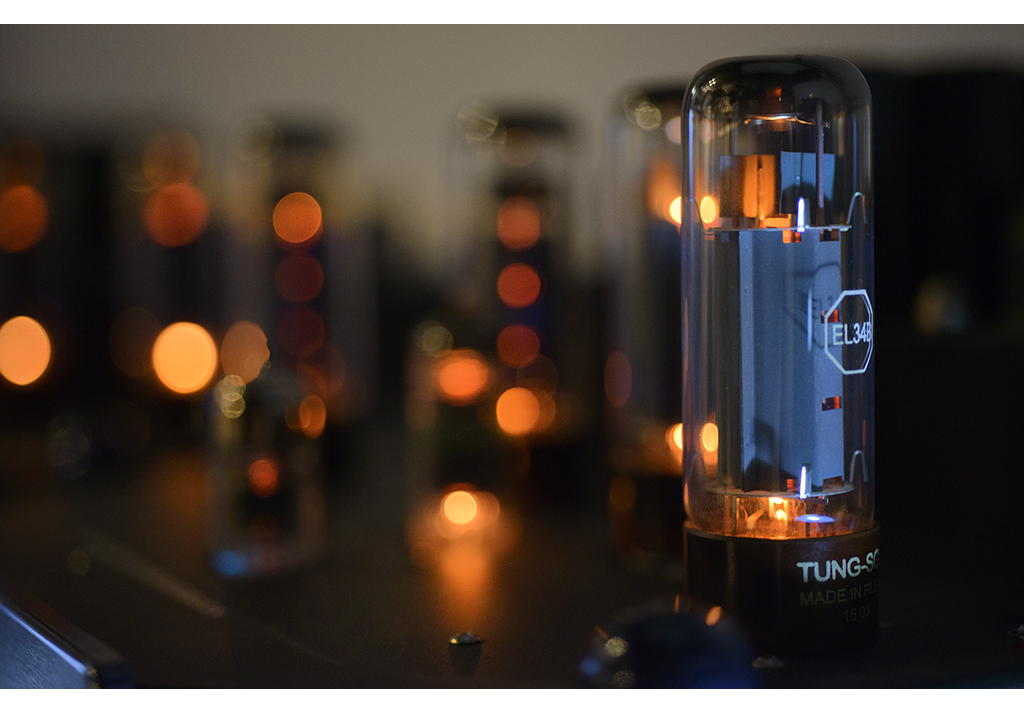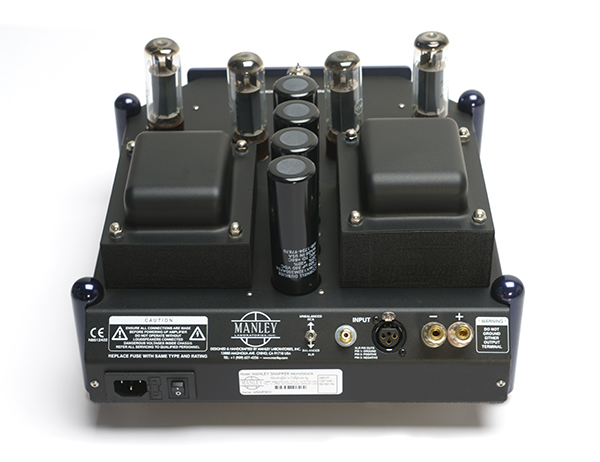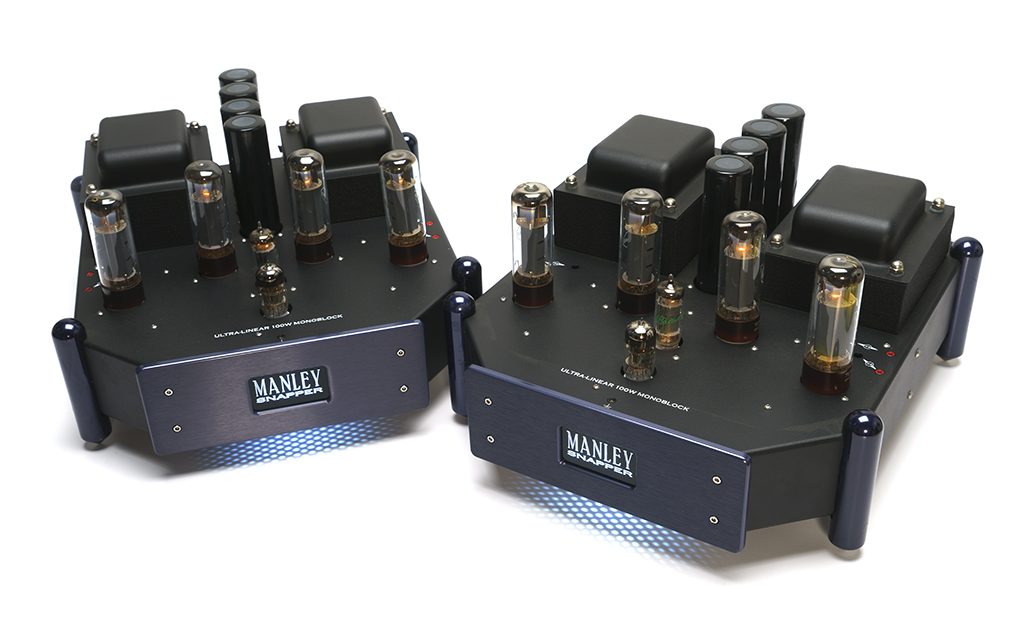The Manley Snapper Monoblocks American Muscle and Finesse
By Jeff Dorgay Spinning Paul Weller’s “Beyond Sunset” just feels right through the Manley Snappers. Founder EveAnna Manley is currently a Southern California being, and these amplifiers instantly bring up that easy beach feeling. The amps are warmed up before the listening begins, and it only takes a few notes to get into the incredible chill vibe that these amplifiers provide.
Spinning Paul Weller’s “Beyond Sunset” just feels right through the Manley Snappers. Founder EveAnna Manley is currently a Southern California being, and these amplifiers instantly bring up that easy beach feeling. The amps are warmed up before the listening begins, and it only takes a few notes to get into the incredible chill vibe that these amplifiers provide.
These days, as many tube amplifier manufacturers are falling over themselves trying to make amplifiers that are hyper-accurate, some are losing their souls in the process. Selfishly speaking, if you’re going to go the tube route, there should be a bit of romance, a bit of feel, a sense that you are really in analog world, eh?
Those tied to the world of measurements (along with the subgroup that believes all amplifiers sound the same) rarely if ever get the magic that a great tube amplifier brings to the party. So, for now, we’re just going to ignore that group. For what it’s worth, Manley says the Snappers will deliver full power at 10Hz all the way to 40KHz. Considering all the electronic music we played while they were here, there’s no reason to doubt this claim. Cranking up all the Massive Attack, Aphex Twin and Tosca tracks we could find are a joy with these amplifiers.
The lowest frequencies are usually where tube amplifiers fall down, getting a little bit soft and uncontrolled at the lowest frequencies. A lot of the genius in tube amplifier design is in circuit refinement and the utmost in care when winding output transformers. Fortunately, there’s no shortage of either at Manley Labs, and like the world’s finest tube amplifier manufacturers, they wind their own. This makes it possible to get exactly what you need for the intended operation, and fine tuning doesn’t break the bank, paying an outside vendor to (hopefully) achieve the desired results.
When I caught up with EveAnna Manley, she confirmed my suspicions about their dedication to the output transformers, which are all wound in-house. “That’s a major motion picture. When we re-did the circuit topology a while back, Mitch went over everything. The output transformers are a 19-section wind. They take about 4 hours to wind one, it’s the best output transformer we make.” This is usually the difference between lesser and greater tube amps.
Fun shape, big value
The Snappers are finished in the standard dark blue color they’ve come in forever, and it’s a fun color. The shape is somewhat of a cross between vintage and contemporary, honoring new and old school industrial design in the process. Each amplifier weighs about 45 pounds each, so nearly anyone can lift them – a real benefit. My favorite part of the aesthetic is the way the Manley logo blinks until the amplifiers warm up – this lets you know the amplifier is in MUTE mode until it’s ready to go.
These amplifiers are a fully balanced, differential design, so they do not rely on transformers to achieve balanced operation. Each mono amplifier uses a 12AX7 input tube, a 5687 (or 7044) driver and four EL-34B output tubes. This adds to the finesse and transient speed that the Snappers offer. A pair of Snappers will set you back $9,399 as of October 1. Considering a pair of PrimaLuna EVO 400s are similarly priced, the McIntosh MC1502 tips the scale at about $12k and the new REF80 from ARC is $15k, the Snappers remain a top value. If you happen to be an audiophile on a budget, that likes to snap up gently used gear, good luck. In the last ten years, I think I’ve seen maybe three pairs of Snappers on the used market. I suggest getting your own pair and hanging on to them forever.
For those of you that aren’t familiar with Manley Labs, they build a lot of gear that works daily in some of the world’s most notable recording and mastering studios. Peeling the onion back further, you’ll be surprised at how many of your favorite tracks have been touched by Manley pro gear over the years. This matters for two reasons. Ms. Manley knows what music is supposed to sound like, and Manley gear doesn’t break. It’s one thing to have your home system crap out in the middle of a weekend listening session, but when something fails in the middle of a record that’s probably going to win a Grammy, heads roll.
Defining the Snapper sound
Sound, especially the sound generated by a playback system is a personal, intimate experience when assembled with care. You know the sound you’re looking for, and you might have to audition many different amplifiers until you find that sound. That sound that makes the tumblers in your cognitive center all snap into place and let you relax, forget about everything and settle in.
If you’ve been on a somewhat long quest for that perfect tube amplifier, and can live with 100 Watts per channel, the Snappers can be your grail. Joe Walsh’s So What? has a big, fat, beefy sound with the Snappers in the system, playing through the Sonus faber Stradiveris. (sans REL six-pack) Every bit of classic rock I love, and have listened to for decades is mega-engaging through the Snappers, regardless of what speakers I use.
The Snappers render music in a fast, lively, and engaging way, without getting too-tubey. Fun as some of our favorite vintage amps from Marantz, McIntosh, and Dynaco are, they have a warm, syrupy, romantic feel. Those of you that worship at the altar of PRAT (pace, rhythm, and timing) will call these vintage amplifiers slow. Depending on your room and system, this can be enticing, but when dynamic material is played, they come up short. Imaging suffers, and there just isn’t that slam you really want. The missing dynamics are the fourth dimension required to make music sound natural when reproduced.
The Snappers really rock. Again, thanks in part to the output transformers and equally because of their overbuilt power supplies. Manley tells me that while tube rectifiers are more romantic, “The solid-state rectifiers allow for bigger power supply caps and more energy storage. That’s the control you’re hearing.” Powering through the massive bass intro to BTOs “Not Fragile” really shows off the finesse these amps exhibit. Those of you with higher brow musical taste might try Stanley Clarkes’ “Bassically Taps.” The great thing about the BTO track, is how well the Snappers keep the grungy, distorted guitars firmly placed over the bass line as it progresses. No matter how complex and layered the mix, the Snappers keep everything where it should be. While they don’t over embellish, like those warmer, tube-y er amps, they do offer a nice degree of tonal saturation that is so pleasing, it’s tough to escape the gravitational pull of the listening chair. Like for hours.

Compatibilities
With 100 Watts each on tap, the Snappers drove everything we paired them with. Having been in the middle of a speaker issue, they were tried with about 20 different speakers, from single driver models, up to the mighty Focal Stella Utopia EMs. (and quite a few in between) There were no issues with any speaker. The Snappers even did a great job with my vintage Acoustat 1+1s, and the Magnepan SMGs – both somewhat notorious to drive.
100 Watts per channel is a nice, sweet spot that makes nearly every speaker your oyster, unless you just have to listen at brain damage levels. I’m a huge fan of the smaller, less powerful Manley Mahi’s (50wpc with EL84 tubes) and they might just be the best amps on Earth for driving a pair of Quad 57s, but sometimes 40 Wpc isn’t always enough to really crank it up. Here’s where you have to think about your priorities (but don’t we all?). The Mahi’s can deliver a little more inner detail, a little bit more of that “pinpoint imaging” that is the catnip for some audiophiles. The Snappers have nearly all that finesse, but with more giddyup. It’s like the difference between a 400cc sport bike and a 600cc sport bike – both are still way more nimble than a full litre bike, but the 600cc bike makes it a little easier to get there.
If you are still intrigued by the Mahi’s, please click here to read our full review.
One more thing worthy of note, while some tube amps these days support an auto-bias configuration, the Snappers need to be biased manually. Manley provides excellent instructions in the owner’s manual and on their website -it’s not that tough. They are even kind enough to include a basic digital multimeter (DMM) so you won’t have to source one. Usually, biasing power tubes needs to be done when they are new, again at about 100 hours, and maybe double check every few hundred hours. Somewhere down the road, one or more of the output tubes will no longer bias up, or you’ll notice a bit of softness in the high frequencies. That’s when it’s time for new tubes. Unless you’re made of money, work with the standard tubes. Rolling EL-34s these days is expensive.
What’s not to love?
If you’re new to tubes, you might just think the Manley Snappers are incredible and be done with it. However, if you’ve sampled your fair share over the years, you’re in for a pleasant surprise at how great a job these monoblocks do at doing it all. Plenty of power, big dynamics, imaging like crazy, and easy to use. (not to mention easy to lift!)
There are other amps with snazzier casework, and snootier pedigrees. But, if you just love music and you want a pair of incredible monoblocks that deliver the goods, I can’t recommend the Manley Snappers highly enough.





